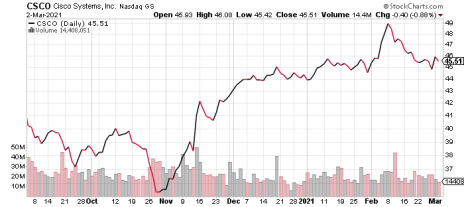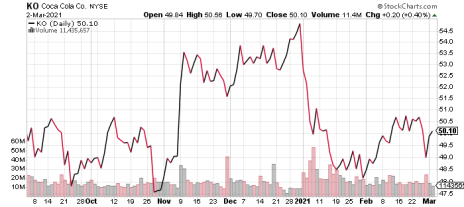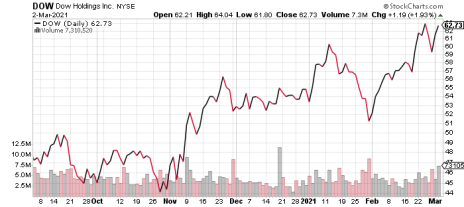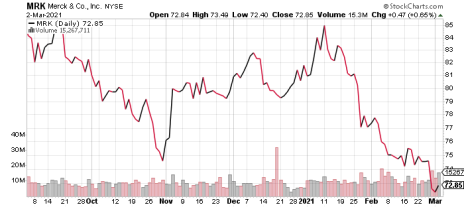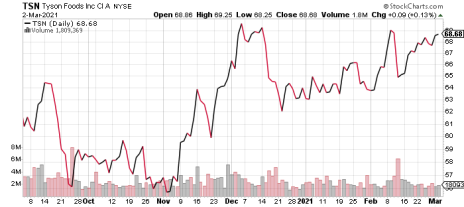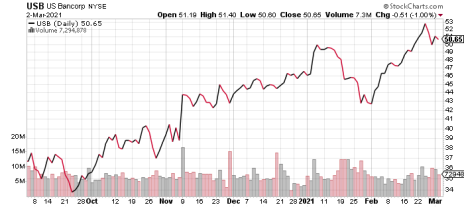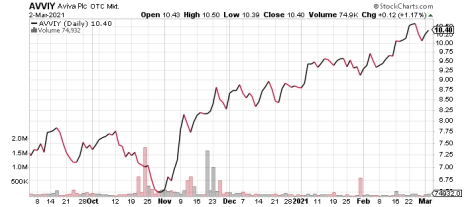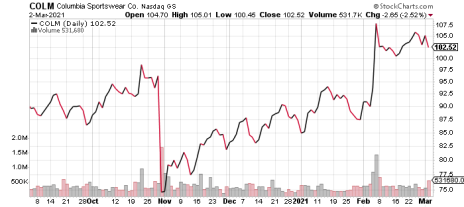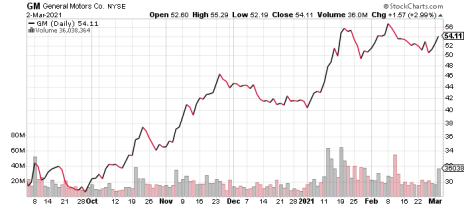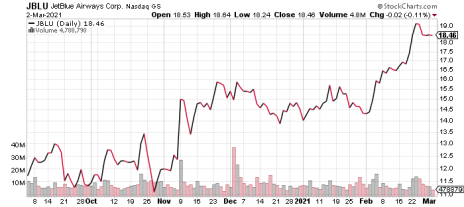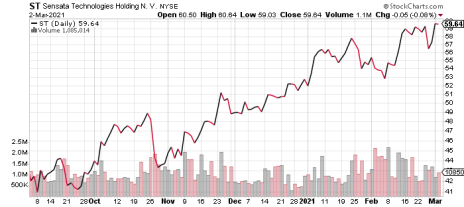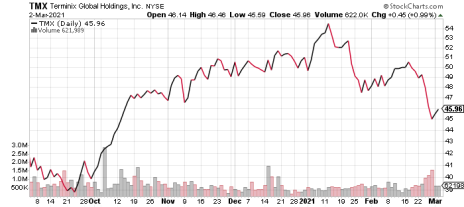Thank you for subscribing to the Cabot Undervalued Stocks Advisor. We hope you enjoy reading the March 2021 issue.
As value investors, we follow the goings-on at Berkshire Hathaway, and comment briefly on its earnings and Warren Buffett’s annual shareholder letter, released this past Saturday. Your chief analyst owns some Berkshire shares (the lower-priced Class B shares), but isn’t a full-fledged Berkshire “groupie.”
We also discuss our new Buy recommendation – British insurance company Aviva, Plc (AVVIY). This company is emerging from a period of global sprawl and weak leadership, led by a new and impressive CEO.
Currently-recommended Dow (DOW) is a strong beneficiary of the global economic re-opening, with higher earnings likely ahead, so we are raising our price target to reflect this still-undervalued stock’s potential.
Please feel free to send me your questions and comments. This newsletter is written for you and the best way to get more out of the letter is to let me know what you are looking for.
I’m best reachable at Bruce@CabotWealth.com. I’ll do my best to respond as quickly as possible.
Thanks!
Cabot Undervalued Stocks Advisor 321
[premium_html_toc post_id="226490"]
Checking In on Berkshire Hathaway
This wouldn’t be a proper value investing letter without mentioning Berkshire Hathaway’s earnings report and chairman Warren Buffett’s annual shareholder letter, released this past Saturday. The earnings were fine, given the pandemic this year, while the letter seemed shorter than typical and more of a reminiscence of the company’s history than sage advice about investing.
His commentary had some harsh words for conglomerates (which he carefully and legitimately differentiates from the Berkshire conglomerate), some favorable words about Berkshire’s large ($24.7 billion) and increasingly less-rare share buybacks, and the good news that both Buffett and Charlie Munger will be on stage together again at the Berkshire Hathaway annual meeting, to be held on May 1st. Like last year, it will be “virtual” only and available for live viewing starting at 1pm EDT on Yahoo! Finance. Your chief analyst holds shares of Berkshire Hathaway (the lower-priced B shares) and has marked his calendar. While by no means a certified Buffett groupie, he finds Buffett and Munger to be an immensely valuable fountain of smarts-and-experience perspective.
In mid-February, with the then-due regulatory filings, we were pleased to learn that Berkshire holds several stocks that the Cabot Undervalued Stocks Advisor recommends. The overlapping roster includes long-standing holdings like Coca-Cola, as well as relatively newer positions in Merck and Bristol-Myers. Other common names include U.S. Bancorp and General Motors.
This week, we’re adding a new name that Buffett may appreciate but almost certainly doesn’t own – Aviva, Plc. This London-based insurance company is undergoing an overhaul, led by the highly capable new CEO Amanda Blanc.
We’re watching market sentiment gyrate sharply between “the economic reopening will boost earnings” and “the economic reopening will boost inflation”. Both outcomes are likely. Our goal is to find stocks that will do well in either situation – a daunting task but one we find fascinating and hopefully rewarding.
Share prices in the table reflect Tuesday (March 2) closing prices. Please note that prices in the discussion below are based on mid-day March 2 prices.
Note to new subscribers: You can find additional color on recent earnings and other news on recommended companies in prior editions of the Cabot Undervalued Stocks Advisor on the Cabot website.
Send questions and comments to Bruce@CabotWealth.com.
Upcoming Earnings Releases
None
Today’s Portfolio Changes
Aviva, Plc (AVVIY) – New Buy.
Dow (DOW) – Raising our price target from 60 to 70.
Portfolio changes during the past month
ViacomCBS (VIAC) – moving from Hold to Sell (See Special Bulletin on February 23rd).
JetBlue (JBLU) – moving from Buy to Hold.
Sensata (ST) – New Buy.
Columbia Sportswear (COLM) – moving from Hold to Sell.
Terminix Global Holdings (TMX) – moving from Hold to Sell.
ViacomCBS (VIAC) – moving from Buy to Hold.
Growth & Income Portfolio
Growth & Income Portfolio stocks are generally higher-quality, larger-cap companies that have fallen out of favor. They usually have some combination of attractive earnings growth and an above-average dividend yield. Risk levels tend to be relatively moderate, with reasonable debt levels and modest share valuations.
| Stock (Symbol) | Date Added | Price Added | 3/2/21 | Capital Gain/Loss | Current Dividend Yield | Price Target | Rating |
| Bristol-Myers Squibb (BMY) | 04-01-20 | 55 | 61 | 12.2% | 3.2% | 78 | Strong Buy |
| Cisco Systems (CSCO) | 11-18-20 | 42 | 46 | 7.9% | 3.2% | 55 | Buy |
| Coca-Cola (KO) | 11-11-20 | 54 | 50 | -7.1% | 3.3% | 64 | Buy |
| Dow Inc (DOW) | 06-05-18 | 68 | 63 | -8.2% | 4.5% | 70 | Hold |
| Merck (MRK) | 12-9-20 | 83 | 73 | -12.2% | 3.6% | 105 | Buy |
| Tyson Foods (TSN) | 12-10-19 | 89 | 69 | -22.9% | 2.6% | 75 | Buy |
| US Bancorp (USB | 12-29-20 | 46 | 51 | 9.4% | 3.3% | 58 | Buy |
Bristol Myers Squibb Company (BMY) is a New York-based global biopharmaceutical company. In November 2019, the company acquired Celgene for a total value of $80.3 billion. We are looking for Bristol Myers to return to and then sustain overall revenue growth, both from resilience in their key franchises (Opdivo, Revlimid and Eliquis) and from new products currently in their pipeline. We also want to see the company execute on its $2.5 billion cost-cutting program which will likely remain intact with the recently completed MyoKardia acquisition.
Bristol Myers’s recent earnings report was encouraging. Adjusted for the Celgene acquisition, sales rose 10% and earnings increased 20%, with both results above consensus estimates. Bristol raised its full year 2021 earnings guidance by 2%, to a midpoint of $7.45 and reaffirmed its longer-term expectations for low-mid single digit revenue growth rate and low-mid 40s non-GAAP operating margin. The company expects to generate between $45 billion and $50 billion in cash flow over the three years of 2021-2023. This sum is equivalent to 35% of the company’s $136 billion market value (our apologies: the previous market cap data was incorrect). The balance sheet is solid. Overall, the story remains intact.
Berkshire Hathaway (Warren Buffett and crew) is the 8th largest shareholder, at 1.5%, and the likely 3rd largest active shareholder behind indexers like Vanguard, BlackRock, State Street, and Fidelity/Geode Capital (unclear as to what extent these two affiliated firms are active or passive). We also see that Dodge & Cox is the 11th largest shareholder, with a 1.2% stake. We have a high regard for this value investment manager’s thorough research and long-term holding period.
There was no significant company news in the past week.
BMY shares rose 1% for the past week and have about 26% upside to our 78 price target. We remain patient with BMY shares.
The stock trades at a low 8.3x estimated 2021 earnings of $7.48 (up 1 cent from last week). On 2022 estimated earnings of $8.11 (also up 1 cent from last week), the shares trade for 7.6x. Either we are completely wrong about the company’s fundamental strength, or the market must eventually recognize Bristol’s earning power. We believe the earning power, low valuation and 3.2% dividend yield that is well-covered by enormous free cash flow makes a compelling story. STRONG BUY.
Cisco Systems (CSCO) generates about 72% of its $48 billion in revenues from equipment sales, including gear that connects and manages data and communications networks. Other revenues are generated from application software, security software and related services, providing customers a valuable one-stop-shop. Cisco is shifting toward a software and subscription model and ramping new products, helped by its strong reputation and its entrenched position within its customers’ infrastructure.
The emergence of cloud computing has reduced the need for Cisco’s gear, leading to a stagnant/depressed share price. Cisco’s prospects are starting to improve under CEO Chuck Robbins (since 2015). The company is highly profitable, generates vast cash flow (which it returns to shareholders through dividends and buybacks) and has a very strong balance sheet.
The fiscal second quarter earnings report was generally bland on the surface, but underlying improvement appears around the corner. Cisco’s earnings grew 3% while revenues were flat. The company guided for third quarter revenue growth of 3.5% to 5.5% and non-GAAP earnings of $0.80 to $0.82 per share. Cisco raised its dividend by 1 cent, or 3%. Commentators lamented yet another (fifth consecutive) revenue decline, but it was essentially flat, and combined with margin expansion, is adequate for now and an improvement from prior quarters. Also, Cisco’s revenues are dampened by an accounting treatment during the transition to a subscription model. About 76% of Cisco’s software revenue is now sold on a subscription basis. Product orders remain subdued but positive at +1%. From our perspective, any growth here is helpful. Cisco’s balance sheet remains solid, with $16 billion in cash net of debt.
Cisco completed its long-pending $4.5 billion acquisition of Acacia Communications.
CSCO shares rose 1% in the past week and have about 20% upside to our 55 price target. The shares have remained resilient even as trendier tech stocks have stumbled.
The shares trade at a low 14.2x estimated FY2021 earnings of $3.22. This estimate rose 3 cents in the past week, likely due to analysts factoring in the accretion from the Acadia deal. On FY2022 earnings (which ends in July 2022) of $3.42, the shares trade for 13.4x. On an EV/EBITDA basis on FY2021 estimates, the shares trade at a discounted 9.8x multiple. CSCO shares offer a 3.2% dividend yield. We continue to like Cisco. BUY.
Coca-Cola (KO) is best-known for its iconic soft drinks but nearly 40% of its revenues come from non-soda brands across the non-alcoholic spectrum, including PowerAde, Fuze Tea, Glaceau, Dasani, Minute Maid and Schweppes. Its vast global distribution system offers it the capability of reaching essentially every human on the planet.
While near-term outlook is clouded by pandemic-related stay-at-home restrictions, secular trends away from sugary sodas, high exposure to foreign currencies (now perhaps a positive) and always-aggressive competition, Coca-Cola’s longer-term picture looks bright. Relatively new CEO James Quincey (2017), a highly regarded company veteran with a track record of producing profit growth and making successful acquisitions, is reinvigorating the company by narrowing its oversized brand portfolio, boosting its innovation and improving its efficiency. The company is also working to improve its image (and reality) of selling sugar-intensive beverages that are packaged in environmentally insensitive plastic. Coca-Cola is supported by a sturdy balance sheet. Its growth investing, debt service and $0.41/share quarterly dividend are well-covered by free cash flow.
Coca-Cola’s fourth quarter earnings grew about 6% from a year ago and was 12% higher than the consensus estimate. Revenues fell 5% from a year ago and was in line with estimates. The company’s recovery is making progress but remains subdued due to pandemic-related lockdowns. Revenues are approaching full recovery while earnings are higher as profit margins are expanding, helped by the company’s efficiency improvements and restructuring efforts.
Full year 2021 guidance is for organic revenue growth of 7%-8% and adjusted earnings per share growth of 9%-12%. This could well be conservative, particularly if the reopening is strong this summer. The company alerted investors to a potential $12 billion settlement for its outstanding tax matter. This is a worst-case scenario and much higher than our initial estimate, but we see little chance of a final loss this large. Coke repaid about $11 billion in debt from cash on hand and will likely continue to generate robust free cash flow in 2021.
There was no significant company news in the past week.
KO shares fell 2% in the past week. The stock has about 28% upside to our 64 price target. While the valuation is not statistically cheap, at 23.2x estimated 2021 earnings of $2.15 (up a cent in the past week) and 21.5x estimated 2022 earnings of $2.32 (unchanged in the past week), the shares are undervalued while also offering an attractive 3.4% dividend yield. BUY.
Dow Inc. (DOW) merged with DuPont in 2017 to temporarily create DowDuPont, then split into three companies in 2019 based roughly along product lines. The new Dow is the world’s largest producer of ethylene/polyethylene, the most widely used plastics. Dow is primarily a cash-flow story driven by three forces: 1) petrochemical prices, which are often correlated with oil prices and global growth, along with competitors’ production volumes; 2) volume sold, largely driven by global economic conditions, and 3) ongoing efficiency improvements (a never-ending quest of all commodity companies to maintain their margins).
On January 28, Dow reported fourth quarter earnings of $0.84/share, well-ahead of the consensus estimate of $0.67/share. Overall, a strong quarter for Dow. Revenues grew 5% compared to a year ago, with higher prices (+2%) and volumes (+1%), helped by a modest currency tailwind (+2%). Free cash flow was strong, and Dow reduced its net debt during the year. The company provided a moderately encouraging 2021 outlook, with higher revenues and profits, along with another $1 billion in net debt reduction.
The company and its markets have moved beyond the pandemic, as volumes reached pre-pandemic levels in all of Dow’s operating segments. As its commodity chemicals are widely used across the global economy, this is encouraging even as the news is filled with grim Covid statistics.
Interestingly, Capital Research, a widely respected investment manager with $2 trillion in assets under management, is the largest shareholder of Dow, with a 14.8% stake – larger than any index fund. This is a fairly strong endorsement.
There was no significant company news in the past week.
Dow shares were flat this past week – not bad when the stock market was jittery. As a producer of a fundamental building block of the global economy, Dow is well-positioned for continued revenue and profit growth. With new and immense government stimulus likely, the rising likelihood that vaccines will allow a fuller opening of the global economy, particularly in the developed world, and as Dow shares still are not expensive in such an economy, we are raising our price target to 70.
The shares trade at 17.2x estimated 2022 earnings of $3.62, although these earnings are more than a year away. This estimate ticked up another 1% in the past week.
The high 4.5% dividend yield is particularly appealing for income-oriented investors. Dow currently is more than covering its dividend and management makes a convincing case that it will be sustained. HOLD.
Merck (MRK) – Pharmaceutical maker Merck focuses on oncology, vaccines, antibiotics and animal health. Keytruda, a blockbuster oncology treatment representing about 30% of total revenues, holds an impressive franchise that is growing at a 20+% annual rate. To tighten its focus, Merck will spin off its Women’s Health, biosimilars and various legacy branded operations, to be named Organon, by mid-year 2021. These businesses currently generate roughly 15% of Merck’s total revenues yet comprise half of its product roster. We estimate that Organon is worth about $3.75 per MRK share. The spin-off will yield an $8-$9 billion cash inflow to Merck. Longer term, we see the company spinning out or selling its animal health business. Merck has a solid balance sheet and is highly profitable. With the new CEO, we see the company becoming more acquisitive to find additional growth products, which adds both risk and return potential to the Merck story.
Primary risks include its dependence on the Keytruda franchise which will face generic competition in late 2028, possible generic competition for its Januvia diabetes treatment starting in 2022, and the possibility of government price controls.
Merck reported a mixed quarter, with earnings rising about 17% from a year ago but falling about 5% below the consensus estimate. Revenues increased 5% from a year ago but were slightly lower than the consensus estimate. The core growth products, Keytruda and Gardasil, as well as the animal health segment, produced good results that offer encouragement for the next few years, at least.
Guidance was favorable and appears conservative, but also included a minor favorable change in how some amortization is treated (which will make the adjusted earnings a tad more flattering) and embedded some optimism on currency changes and doctor visits.
Berkshire Hathaway (Warren Buffett and crew) is the 9th largest shareholder, at 1.1%, and the 5th largest active shareholder behind indexers like Vanguard, BlackRock, State Street, and Geode Capital. We also see that Capital Research and Wellington Management, both highly regarded for their value-oriented and thorough research approach and long-term holding periods, are the 4th and 6th largest shareholders, respectively.
Merck announced that it was acquiring Pandion Therapeutics (PAND) for $1.85 billion, or $60/share, in cash. Pandion is a clinical stage (essentially no revenues) autoimmune company that completed its IPO last July. The acquisition is a step toward finding new growth avenues to eventually replace Keytruda’s loss of patent exclusivity. The price is a roughly 125% premium above PAND’s prior day close. Pandion had $232 million in cash with no debt at its most recent quarter-end, which would effectively reduce the price by about 12%. Curiously, Pandion’s shares are trading above 60, indicating the possibility that another bidder will top Merck’s offer – an outcome which we see as unlikely. Whether the premium represents overvaluation or a savvy deal is impossible to determine, given the early stage of Pandion’s products.
For much of this year, we anticipate that the stock will be volatile or remain weak until the effects of the strategic changes are more clearly seen. Longer term, the low valuation, strong balance sheet and sturdy cash flows provide real value. The 3.6% dividend yield pays investors to wait.
Merck shares slipped 2% this past week and have about 43% upside to our 105 price target. Valuation is an attractive 11.3x this year’s estimated earnings of $6.47 (up a cent this past week). Merck produces generous free cash flow to fund this dividend as well as likely future dividend increases, although its likely shift to a more acquisition-driven strategy will likely slow the pace of increases. BUY.
Tyson Foods (TSN) is one of the world’s largest food companies, with nearly $43 billion in revenue. Beef products generate about 36% of total revenues, while chicken (31%), pork (10%), and prepared/other contribute the remaining revenues. It has the #1 domestic position in beef and chicken with roughly 21% market share in each. Its well-known brands include Tyson, Jimmy Dean, Hillshire Farms, Ball Park, Wright and Aidells. Tyson’s long-term growth strategy is to participate in the growing global demand for protein. The company has more work to do to convince investors that its future is brighter, particularly as it is more of a commodity company (and hence has lower margins) compared to its food processor peers. Dean Banks, the new CEO, who previously was an Alphabet/Google executive, is starting to make necessary changes.
Tyson’s first quarter earnings were strong, rising by 28% and were well-ahead of estimates, excluding the effect of a $230 million accrual to settle price-fixing charges. Revenues fell by 4% as higher prices were more than offset by lower volume. TSN shares responded with a down day, likely due to 2021 guidance that pointed to a flat/down earnings year compared to 2020. Management anticipates slightly positive/flat volumes for its beef, pork and chicken, flat pricing, and higher feed costs for chickens. Prepared Foods will likely see higher profits but this is a small segment for Tyson.
There was no significant company news in the past week.
The stock was flat in the past week and has about 10% upside to our 75 price target. Valuation is attractive at 12.0x estimated 2021 earnings of $5.69. This estimate was unchanged in the past week. Currently the stock offers a 2.6% dividend yield. BUY.
U.S. Bancorp (USB), with a $70 billion market value, is the one of the largest banks in the country. It focuses is on consumer and commercial banking through its 2,730 branches in the midwest, southwest and western United States. It also offers a range of wealth management and payments services. Unlike majors JP Morgan, Bank of America and Goldman Sachs, U.S. Bancorp has essentially no investment banking or trading operations. USB shares remain out of favor due to worries about a potential surge in pandemic-driven credit losses and weaker earnings due to the low interest rate environment.
Recent fourth quarter earnings were healthy and reflect the bank’s enduring strength in its profitability, capital and credit reserves. The shares fell on the news, in line with most other banks, as investors expected more encouraging near-term results and a faster recovery.
Bolstering its reputation, U.S. Bancorp was named one of the world’s most ethical companies for 2021 by Ethisphere Institute. We know little about this group, but their results certainly don’t hurt the bank.
The interest rate environment is improving, as the 10-year Treasury yield is now 1.43%, up from about 0.92% at year-end, although this has slipped a tad from about 1.50% late last week. For reference, the yield was 1.88% at year-end 2019, just before the pandemic. Short-term interest rates have remained essentially unchanged.
The shares were flat in the past week and have about 14% upside to our 58 price target. Rising interest rates combined with a stronger economy make the bank more valuable.
Valuation is a modest 12.1x estimated 2022 earnings of $4.24. This estimate increased by about 1% in the past week. On a price/tangible book value basis, USB shares trade at a reasonable 2.1x multiple of the $24.85 tangible book value. This ratio ignores the value of its payments, investment management and other service businesses that have low tangible book values but produce steady and strong earnings. Currently the stock offers an appealing 3.3% dividend yield. BUY.
Buy Low Opportunities Portfolio
Buy Low Opportunities Portfolio stocks include a wide range of value opportunities, often with considerable upside. This group may include stocks across the quality and market cap spectrum, including those with relatively high levels of debt and a less-clear earnings outlook. The stocks may not pay a dividend. In all cases, the shares will trade at meaningful discounts to our estimate of fair value.
| Stock (Symbol) | Date Added | Price Added | 3/2/21 | Capital Gain/Loss | Current Dividend Yield | Price Target | Rating |
| Aviva (AVVIY) | 03-02-21 | 10 | 10 | -0.2% | 5.6% | 14 | Buy |
| Columbia Sportswear (COLM) | 06-30-20 | 80 | 103 | 28.4% | — | 100 | Sell |
| General Motors (GM) | 12-31-19 | 37 | 54 | 48.1% | — | 62 | Hold |
| JetBlue (JBLU) | 11-25-20 | 16 | 18 | 16.8% | — | 19 | Hold |
| Molson Coors (TAP) | 08-04-20 | 37 | 45 | 22.4% | — | 59 | Buy |
| Sensata Technologies (ST) | 02-16-21 | 59 | 60 | 0.9% | — | 75 | Buy |
| Terminix Global Holdings (TMX) | 10-13-20 | 45 | 49 | 9.8% | — | 57 | Sell |
| ViacomCBS (VIAC) | 08-26-20 | 28 | 69 | 149.2% | 1.4% | 65 | Sell |
New BUY: Aviva, PLC (AVVIY) – Based in London, England, Aviva is a major European insurance company specializing in life insurance, savings and investment management products. Its market cap is about $21 billion, and is expected to generate about $65 billion in revenues and about $2.8 billion in profits in 2020. Long a mediocre company, the frustrated board last July installed Amanda Blanc as the new CEO, with the task of fixing the business. She is aggressively refocusing the company on its core geographic markets (UK, Ireland, Canada), with its continental Europe and Asia operations potentially on the selling block. Recently, Aviva announced the sale of its operations in Turkey. The turnaround also includes improving Aviva’s product competitiveness, rebuilding its financial strength and trimming its bloated costs.
The new leadership reduced the company’s dividend, but to a more predictable and sustainable level that will be on a modest but upward trajectory. Based on current share prices, the yield is about 5.6%. The stock trades at 6.7x estimated 2021 earnings and about 90% of tangible book value. With the company’s aggressive operating and strategic improvement, we expect higher earnings and a modest multiple expansion will lift the shares to our $14 price target. While the ordinary shares trade in London, American investors can buy the American Depositary Shares (ADS) which trade with plenty of liquidity in the United States (1 ADS = 2 ordinary shares). Potential investors will want to note that the company will report earnings on March 4th. BUY.
Columbia Sportswear (COLM) produces the highly recognizable Columbia brand outdoor and active lifestyle apparel and accessories, as well as SOREL, Mountain Hardware, and prAna products. Columbia’s strong results are enough to essentially prove that it will return to pre-pandemic levels of revenues and profits, and probably a bit higher, validating our initial thesis. Fundamentally, we see few problems with Columbia other than valuation. The market is more fully pricing in this recovery, with the shares trading at just over 20x what could be $5.00/share in earnings in 2022.
On February 10th, we moved COLM to a SELL, with a 27% profit since our initial recommendation in July 2020. Risks, other than the elevated valuation, include possible structural headwinds that could permanently impair the value of its retail store base, as well as slower-than-expected sales growth once the pandemic stimulus programs expire. SELL.
General Motors (GM) under CEO Mary Barra (since 2014) has transformed from a lumbering giant to a well-run and (almost) respected auto maker. The company has smartly exited many chronically unprofitable geographies (notably Europe) and trimmed its passenger car roster while boosting its North American market share with increasingly competitive vehicles, particularly light trucks. We consider its electric and autonomous vehicle efforts to be near industry-leading. We would say it is perhaps 75% of the way through its gas-powered vehicle turnaround, and is well-positioned but in the very early stages of its EV development. GM’s balance sheet is sturdy, with Automotive segment cash exceeding Automotive debt. Its credit operations are well-capitalized but may yet be tested as the pandemic unfolds.
General Motors reported an encouraging fourth quarter that keeps the attractive long-term picture intact but includes some near-term one-off headwinds. Earnings were well-ahead of the consensus estimate. Automotive revenues grew 25% from a year ago – impressive during a pandemic. Much of the profit growth came from higher prices that nearly offset the drag from lower volume. GM Financial continues to generate healthy profits. GM’s earnings slide deck highlighted its commitment to electric and other alternative vehicles and initiatives. By 2025, the company will launch 30 new electric vehicles, reiterating comments made earlier this year.
The company’s forward guidance for full year 2021 adjusted earnings of between $4.50 and $5.25, however, was weaker than the consensus estimate of $6.04 – a shortfall of about 19%. Most of the reduction is due to the computer chip shortage that will require the company to curtail production in vehicles other than its highly profitable full-sized pickup trucks. We think some of the profit reduction is also due to higher prices GM will pay to secure its chip supplies.
Last week, GM said that the worst of the chip shortage, from its perspective, may be behind it. The company’s CFO said this improvement increases GM’s chances of meeting its revenue and earnings guidance for the year.
The company is only moderately vulnerable to small increases in interest rates as this headwind would be overpowered by the strengthening job market. However, large increases in interest rates, that would push 10-year Treasury yields to, say, 3%, would risk an economic slowdown. Also, it might reduce the value of GM Financial’s loan portfolio even though the segment would generate higher spread profits (borrowing at low short-term interest rates while lending at higher longer-term interest rates).
GM shares rose 1% in the past week, with 18% upside to our 62 price target. With some settling of last week’s market volatility, the shares appear to be recovering.
On a P/E basis, the shares trade at 8.4x estimated calendar 2022 earnings of $6.26 (down about 1% this past week). The P/E multiple is helpful, but not a precise measure of GM’s value, as it has numerous valuable assets that generate no earnings (like its Cruise unit, which is developing self-driving cars and produces a loss), its nascent battery operations, its Lyft stake and other businesses with a complex reporting structure, nor does it factor in GM’s high but unearning cash balance which offsets its interest-bearing debt. However, it is useful as a rule-of-thumb metric and we will continue its use here.
Our 62 price target is a more detailed analysis of GM’s various components and their underlying valuation. HOLD.
JetBlue Airlines (JBLU) is a low-cost airlines company. Started in 1999, the company serves nearly 100 destinations in the United States, the Caribbean and Latin America. The company’s revenues of $8.1 billion in 2019 compared to about $45 billion for legacy carriers like United, American and Delta, and were about a third of Southwest Airlines ($22 billion). Its low fares and high customer service ratings have built strong brand loyalty, while low costs have helped JetBlue produce high margins. Its TrueBlue mileage awards program, which sells miles to credit card issuers, is a recurring source of profits.
We believe consumers (and eventually business travelers) are likely to return to flying. JetBlue has aggressively cut its cash outflow to endure through the downturn. Although its $4.8 billion debt is elevated, its $3.6 billion cash balance gives the airline plenty of time to recover. JBLU shares carry more risk than the typical CUSA stock.
On January 28, JetBlue reported reasonable fourth quarter results. The loss of $(1.53)/share compared to a profit of $0.56/share in the pre-pandemic fourth quarter last year and was better than the consensus estimate. Revenue fell 67% from a year ago to $661 million, but was slightly better than the consensus estimate. However, investor expectations for the eventual recovery are being pushed out.
The company’s reported daily cash burn rate was $6.7 million – about what was expected. JetBlue will revert to reporting EBITDA, so investors will also focus on this metric, although we will continue to pay close attention to cash outflows. The company’s $3.1 billion in cash offers plenty of reserves until revenues ramp up to a break-even cash burn rate, likely in early 2022. If customer demand in 2022 fully reaches the 2019 level, JetBlue should produce larger profits than in 2019 due to its now-lower cost structure. The company sounds pro-active in managing the business, with a common-sense approach, and is well-positioned for a demand recovery. We will patiently wait.
There was no significant company news in the past week.
JBLU shares slipped 1% this past week after a surge above our 19 price target. Currently, the shares have about 4% upside to our 19 price target. If the shares sustain a move above 19, we’ll review our rating for either a price target raise or a sell. We see a lot of reasons to be optimistic about Jet Blue’s post-pandemic earnings potential, yet we balance this against the extent that these earnings are priced into the shares.
The stock trades at 8.9x estimated 2023 earnings of $2.06. This estimate rose 7% in the past week. Increasingly, the company will likely reach a “full recovery” in earnings in 2023 rather than 2022. We are watching the 2021 estimated loss per share to quantify near-term conditions. This estimate jumped to $(2.26), improving upon last week’s estimate by 24 cents. More optimism about vaccines and an economic reopening are fueling the higher estimates. On an EV/EBITDA basis, the shares trade at 5.3x estimated 2023 EBITDA. HOLD.
Molson Coors Beverage Company (TAP) – The thesis for this company is straight-forward – a reasonably stable company whose shares sell at an overly discounted price. One of the world’s largest beverage companies, Molson Coors produces the highly recognized Coors, Molson, Miller and Blue Moon brands as well as numerous local, craft and specialty beers. About two-thirds of its $10 billion in net revenues are produced in the United States, where it holds a 24% share of the beer market.
Investors’ primary worry about Molson Coors is its lack of meaningful (or any) revenue growth as produces relatively few of the fast-growing hard seltzers and other trendier beverages. Our view is that the company’s revenues are resilient, it produces generous cash flow and is reducing its debt, traits that are value-accretive and underpriced by the market. A new CEO is helping improve its operating efficiency and expand carefully into more growthier products.
Molson reported disappointing fourth quarter results, with adjusted earnings per share of $0.40 declining 60% from a year ago and falling well short of the $0.77 consensus estimate. Revenues of $2.3 billion fell 8% from a year ago and were about 5% below estimates. The shortfall appears to be directly related to the sluggish re-opening of the European economies, along with higher commodity and marketing costs. Guidance appears conservative but investors weren’t interested, leading to a sell-off in TAP shares. We believe the reopening combined with already-sturdy cash flow will drive the shares higher later in the year. The company will likely re-instate its dividend later this year, which could provide a 3.1% yield.
Global competitor Anheuser-Busch InBev reported a disappointing quarter, weighing on Molson Coors’ shares even though the companies’ operations have different geographic mixes.
TAP shares slipped 1% in the past week and have about 31% upside to our 59 price target. The shares are incrementally more attractive because of the price drop, not less. We see no change in the company’s longer-term prospects regardless of the earnings report, and now have a chance to buy more shares at a lower price.
Earnings estimates stabilized this past week and the 2022 estimate ticked up a cent. TAP shares trade at 11.6x estimated 2021 earnings of $3.87 (unchanged this past week). This valuation is low, although not the stunning bargain from a few months ago.
On an EV/EBITDA basis, or enterprise value/cash operating profits, the shares trade for about 8.3x current year estimates, among the lowest valuations in the consumer staples group and well below other brewing companies.
For investors looking for a stable company trading at a low valuation, TAP shares continue to have contrarian appeal. Patience is the key with Molson Coors. We think the value is solid although it might take a year or two to be fully recognized by the market. BUY.
Sensata Technologies (ST) is a $3 billion (revenues) producer of an exceptionally broad range (47,000 unique products) of sensors used by automotive, industrial, heavy vehicle and aerospace customers. These products are typically critical components, yet since they represent a tiny percentage of the end-products’ total cost, they generally can yield high profit margins. Also, they tend to have relatively high switching costs – vehicle makers are reluctant to switch to another supplier that may have lower prices but lower or unproven quality. Sensata is showing healthy revenue growth (+7% in the fourth quarter), produces strong profits and free cash flow, has a reasonably sturdy balance sheet (debt/EBITDA of about 3.5x) and a solid management team. The company was founded in 1916, owned by Texas Instruments for decades, and returned to public ownership in 2010.
Sensata’s growth prospects look appealing. The company is leveraged to the automobile cycle (about 60% of revenues), which provides cyclical growth, plus added growth as Sensata usually grows faster than the industry. It should benefit from overall economic growth as it serves heavy/off-road (trucking and construction), industrial and aerospace customers. As vehicles become more electrified, Sensata’s products will be used for more applications, further driving revenues. Recently, Sensata acquired Lithium Balance, which provides it with a valuable entre into the electric vehicle battery industry.
Risks include a possible automotive cycle slowdown, chip supply issues, geopolitical issues with China and difficulty integrating its acquisitions.
There was no meaningful company news this past week.
ST shares rose 1% in the past week and have about 26% upside to our 75 price target.
The shares trade at 15.5x estimated 2022 earnings of $3.84 (unchanged). On an EV/EBITDA basis, ST trades at 12.4x estimated 2022 EBITDA. ST shares may be volatile so investors may want to buy a partial position now and buy more on pullbacks. BUY.
Terminix Global Holdings (TMX) is both a new company and an old company. While the name “Terminix” is one of the largest and most widely recognized names in pest control, the company previously was obscured inside of the ServiceMaster conglomerate. With the sale of ServiceMaster Brands, the company changed its name to Terminix. The company appears to have fully addressed its legal liability from deficient termite treatments, removing an overhang on its shares.
On February 10th, we moved Terminix to a SELL. While the stock had not reached our price target, we believed the risk/reward was no longer favorable, partly due to information that we recently learned about the company. We see no imminent problems nor any fraud or other inappropriate conduct, but believe that the turnaround will be more complicated and volatile, with a less-attractive three-year endgame than we initially anticipated.
Our exit of Terminix produced about an 8% profit. SELL.
ViacomCBS (VIAC) is a global media and entertainment company, owning highly recognized properties including Nickelodeon, Paramount movie studios, Showtime and all of the CBS assets. Viacom and CBS merged in late 2019. Under the capable leadership of former Viacom CEO Robert Bakish, the company is overhauling itself to stabilize its revenues, boost its relevancy and improve its free cash flow. A key change is shifting away from advertising and affiliate fees toward content licensing – essentially renting its vast library of movies, TV shows and other content to third-party firms like Netflix and others. Viacom is building out its own streaming channel (Paramount+) and other new distribution channels, which are generally showing fast growth. Its valuable CBS Sports franchise may be a beneficiary of the rapidly growing online sports betting industry.
As its market value now exceeds $40 billion, we see a diminished likelihood that it will be acquired. Also, Viacom’s revenues remain under pressure from the secular shift away from cable TV subscriptions.
Last week, with the shares continuing to surge past our recently raised 65 price target, and being priced at a premium to even our upgraded valuation metrics, we moved the shares to a SELL.
ViacomCBS’s fundamentals look healthy, so our call is driven by the valuation. The shares are increasing becoming a “growth story” and have moved beyond the “undervalued story” that is the focus of our strategy.
VIAC shares produced a total return of approximately 142% from our initial recommendation for the Cabot Undervalued Stocks Advisory on August 26, 2020 at 27.57. SELL.
Strong Buy – This stock offers an unusually favorable risk/reward trade-off, often one that has been rated as a Buy yet the market has sold aggressively for temporary reasons. We recommend adding to existing positions.
Buy – This stock is worth buying.
Hold – The shares are worth keeping but the risk/return trade-off is not favorable enough for more buying nor unfavorable enough to warrant selling.
Sell – This stock is approaching or has reached our price target, its value has become permanently impaired, or changes in its risk or other traits warrant a sale.
The next Cabot Undervalued Stocks Advisor issue will be published on April 7, 2021.
Cabot Wealth Network
Publishing independent investment advice since 1970.
President & CEO: Ed Coburn
Chairman & Chief Investment Strategist: Timothy Lutts
176 North Street, PO Box 2049, Salem, MA 01970 USA
800-326-8826 | support@cabotwealth.com | CabotWealth.com
Copyright © 2021. All rights reserved. Copying or electronic transmission of this information is a violation of copyright law. For the protection of our subscribers, copyright violations will result in immediate termination of all subscriptions without refund. No Conflicts: Cabot Wealth Network exists to serve you, our readers. We derive 100% of our revenue, or close to it, from selling subscriptions to its publications. Neither Cabot Wealth Network nor our employees are compensated in any way by the companies whose stocks we recommend or providers of associated financial services. Disclaimer: Sources of information are believed to be reliable but they are not guaranteed to be complete or error-free. Recommendations, opinions or suggestions are given with the understanding that subscribers acting on information assume all risks involved. Buy/Sell Recommendations: All recommendations are made in regular issues or email alerts or updates and posted on the private subscriber web page. Performance: The performance of this portfolio is determined using the midpoint of the high and low on the day following the recommendation. Cabot’s policy is to sell any stock that shows a loss of 20% in a bull market or 15% in a bear market from the original purchase price, calculated using the current closing price. Subscribers should apply loss limits based on their own personal purchase prices.


